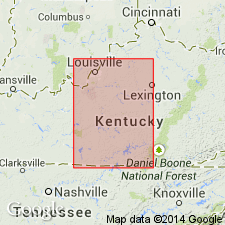
- Usage in publication:
-
- Jabez Sandstone Member*
- Modifications:
-
- Named
- Dominant lithology:
-
- Sandstone
- AAPG geologic province:
-
- Cincinnati arch
Summary:
Named Jabez Sandstone Member of Fort Payne Formation. Typically consists of medium-grained (size range: very fine to coarse), well-sorted, angular, quartz-rich sand, which commonly contains abundant pelmatozoan plates and fragments and also contains sparse detrital feldspar, rock fragments, and argillaceous matrix. It is gray to yellowish gray, dense where fresh. Predominant sedimentary structure is planar bedding; cross-beds are less common. Resembles the Knifely Sandstone Member. Forms a sandstone prism that is 10 km (6 mi) long (trending northwest), 6.5 km (4 mi) wide, and with a maximum thickness of 43 m (140 ft). The body has an initial dip towards the southwest. Enclosed, for the most part, within the Fort Payne Formation; upper part of prism overlain by Salem and Warsaw Formations. Age is Early Mississippian.
Source: GNU records (USGS DDS-6; Reston GNULEX).
For more information, please contact Nancy Stamm, Geologic Names Committee Secretary.
Asterisk (*) indicates published by U.S. Geological Survey authors.
"No current usage" (†) implies that a name has been abandoned or has fallen into disuse. Former usage and, if known, replacement name given in parentheses ( ).
Slash (/) indicates name conflicts with nomenclatural guidelines (CSN, 1933; ACSN, 1961, 1970; NACSN, 1983, 2005, 2021). May be explained within brackets ([ ]).

